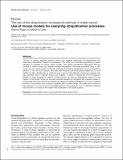| dc.contributor.author | Rossi, Sabrina | |
| dc.contributor.author | Loda, Massimo | |
| dc.date.accessioned | 2013-01-07T21:16:21Z | |
| dc.date.issued | 2003 | |
| dc.identifier.citation | Rossi, Sabrina, and Massimo Loda. 2003. The role of the ubiquitination–proteasome pathway in breast cancer: Use of mouse models for analyzing ubiquitination processes. Breast Cancer Research 5(1): 16-22. | en_US |
| dc.identifier.issn | 1465-5411 | en_US |
| dc.identifier.uri | http://nrs.harvard.edu/urn-3:HUL.InstRepos:10139941 | |
| dc.description.abstract | Turnover of several regulatory proteins results from targeted destruction via ubiquitination and subsequent degradation through the proteosome. The timely and irreversible degradation of critical regulators is essential for normal cellular function. The precise biochemical mechanisms that are involved in protein turnover by ubiquitin-mediated degradation have been elucidated using in vitro assays and cell culture systems. However, pathways that lead to ubiquitination of critical regulatory proteins in vivo are more complex, and have both temporal and tissue-specific differences. In vivo models will allow identification of substrates and enzymes of the ubiquitin–proteosome pathway that play important roles in selected tissues and diseases. In addition, assessment of the therapeutic efficacy of drugs designed to inhibit or enhance protein turnover by ubiquitination requires in vivo models. In the present review we describe selected examples of transgenic and knockout models of proteins that are known either to be regulated by ubiquitin-mediated degradation or to have a catalytic function in this process, and to play an important role in breast cancer. We outline the functions of these proteins in vivo and focus on knowledge gained in the comparison of in vivo behavior predicted from cell-free in vitro data or from experiments conducted in cell culture systems. | en_US |
| dc.language.iso | en_US | en_US |
| dc.publisher | BioMed Central | en_US |
| dc.relation.isversionof | doi://10.1186/bcr542 | en_US |
| dc.relation.hasversion | http://www.ncbi.nlm.nih.gov/pmc/articles/PMC154128/pdf/ | en_US |
| dash.license | LAA | |
| dc.subject | E6-AP | en_US |
| dc.subject | mdm2 | en_US |
| dc.subject | mouse models | en_US |
| dc.subject | p27 | en_US |
| dc.subject | Skp 2 | en_US |
| dc.subject | ubiquitin | en_US |
| dc.subject | Wnt-1 | en_US |
| dc.subject | β-catenin | en_US |
| dc.title | The Role of the Ubiquitination–Proteasome Pathway in Breast Cancer: Use of Mouse Models for Analyzing Ubiquitination Processes | en_US |
| dc.type | Commentary or Review | en_US |
| dc.description.version | Version of Record | en_US |
| dc.relation.journal | Breast Cancer Research | en_US |
| dash.depositing.author | Loda, Massimo | |
| dc.date.available | 2013-01-07T21:16:21Z | |
| dash.affiliation.other | HMS^Pathology | en_US |
| dc.identifier.doi | 10.1186/bcr542 | * |
| dash.contributor.affiliated | Loda, Massimo | |


